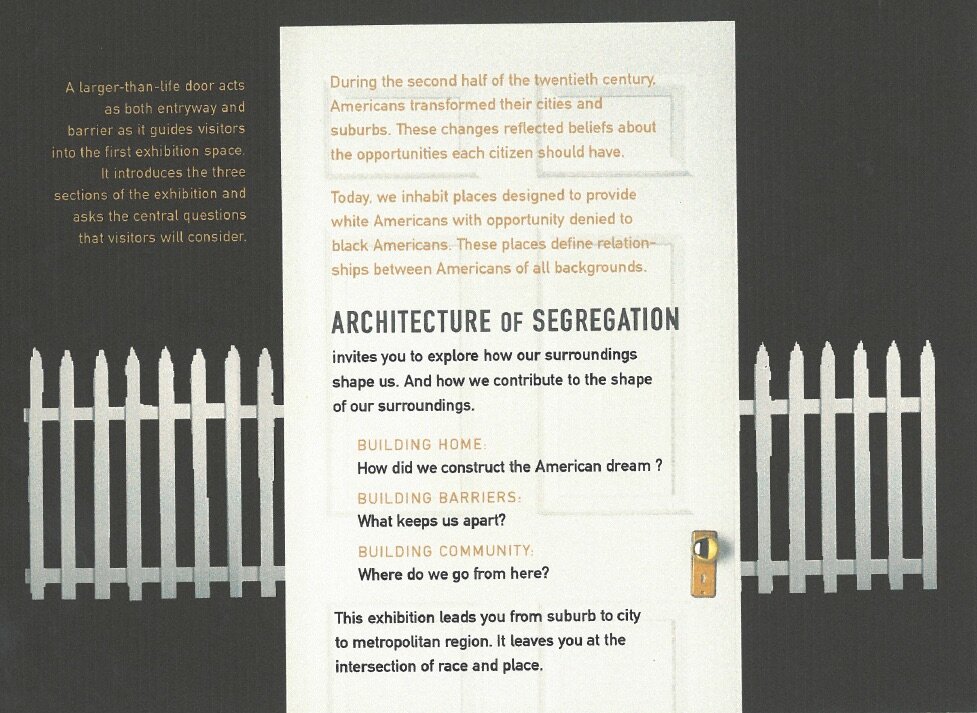Architecture of Segregation







Architecture of Segregation
Architecture of Segregation, a multiplatform project originally planned to include a symposium, book, and exhibition, explores how attitudes about race shaped environments that maintain divisions in American society. The project is intended to engage a broad audience in considering the significance of race in the history of the U.S. landscape, beginning with their homes. It presents structures—roads, schools, houses, and shopping malls, along with the legal and social systems essential to their existence—molding Black and White identities and attitudes. The project asks people to envision how we might rebuild to promote diversity, inclusion, and equity.
Conceived more than 25 years ago, Architecture of Segregation encountered challenges that prevented its reaching a broad public.
Architecture of Segregation presents a series of interlocking stories about relationships among society, race, place, and history. These are explored in four themes:
• People shape place, so place expresses the values of the people that construct it.
• Place shapes what people believe about themselves and others.
• The link between place and values ensures that the American landscape maintains divisions based on race and preserves race-based inequality.
• Despite a divided landscape, Americans are united by shared historical experiences.
A diverse group of advisors, contributors, and organizations formed the core team behind the project. It approached complex humanities subjects by focusing on everyday life and organizing stories under clear themes. This strategy was behind the national success of projects such as Barn Again!, Between Fences, and Me, Myself and Infrastructure, which demonstrated that audiences are eager to question contemporary life and reflect on possible futures.
Architecture of Segregation began in 1998 with the symposium I organized as a Loeb Fellow at the Harvard Graduate School of Design; the fellowship and GSD supported the symposium. Participants included Craig Evan Barton, Howard Gillette, Grace Elizabeth Hale, Randall Kennedy, Theodore Landsmark, Jacqueline Leavitt, Angel David Nieves, Byron Rushing, Theodore M. Shaw, Randy Swearer, June Manning Thomas, and John Michael Vlach.
With the National Building Museum as originating venue, I worked to assemble a network of museums. Finding the financial support for the modest exhibition proved to be challenging. Although experts regard much of the U.S. as hyper-segregated, some museums felt the issue was ‘controversial’ or that it did not apply to their regions. There was concern about the focus on Black/White stories. Several museums were supportive, but we decided to put the project on hold. Institutional attitudes may be different today.
Scholars prepared essays for an illustrated publication, which was to be funded by the Graham Foundation and published by the New Press. The book was planned to appear when the traveling exhibition premiered. Contents:
Home – Gregory Dreicer
Birth - Mindy Fullilove
Education - Waldo Martin
Work - Jacqueline Jones
Housing - Gwendolyn Wright
Transportation - Raymond Mohl
Leisure - Maurice Berger
Neighborhood Living - Lise Funderburg
Worship - June Manning Thomas
Death - John Michael Vlach
Much later, in 2011, a Chicago institution agreed to become the venue for the exhibition, a local publisher agreed to produce the book, and a grant for publication was secured. But the venue decided not to mount the exhibition.
Although nationwide controversies regularly erupt over race, many Americans do not grasp the history of the spaces that they intuitively recognize as segregated—or how these maintain inequality in everyday life, including access to housing, education, health care, transportation, and job opportunity. During a period of uncertain and sometimes violent encounters around race, an accessible public project that presented the inseparable history of place and race would provide rich opportunities for public participation and reflection.